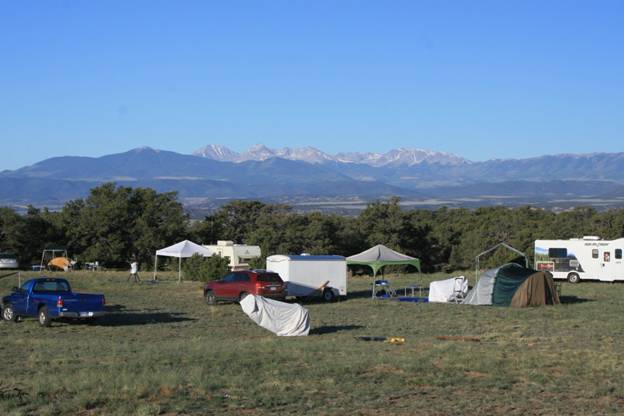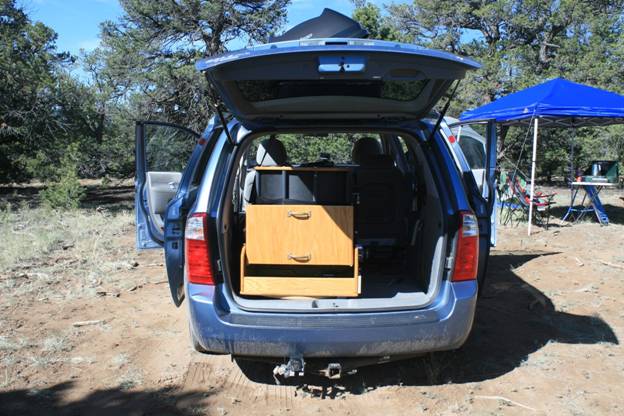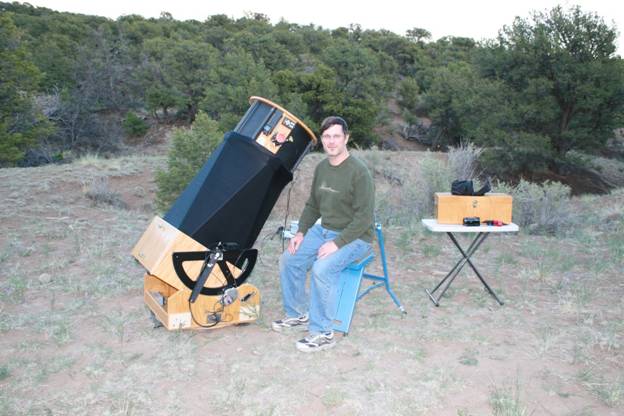Ground-Based Observingat
the Rocky Mountain Star Stare
|
One of my favorite Star Party outings is the Rocky Mountain Star Stare held just north of Gardner Colorado. For several years, we brought our 30” F/3.7 Dobsonian and its tracking platform as our primary instrument. The views from this scope were amazing, but transporting the instrument from Illinois to Colorado was a chore, so the fateful decision was made to rebuild this scope into something lighter and easier to transport. Months of on again – off again tinkering with balsa and carbon fiber all turned up unsuccessful, and as our 2013 departure date neared, it became clear the revised version of the 30” was not going to be ready to go. Although not happy with the situation, I was forced to admit defeat and made tentative plans to take my 20” F/4.3 Starmaster as my primary scope. Upon hearing of this change in plans, Mike Lockwood kindly offered up his 20” F/3 “Shorty” as an alternative. This scope would offer me a fun opportunity– I’d be doing ‘Ground Based Observing’ -- no ladder required for a 20” Dobsonian.  A morning portrait of the observing grounds only hints at the beautiful setting. |
Transportation If you think you don’t have space for a 20” telescope in your vehicle, you probably have too many passengers or way too much stuff. As can be seen below, fitting the 20” into a minivan is quite easy. A pet peeve of mine -- some of the other Dobsonians have an upper tube assembly whose diameter is larger than the mirror box, making stacking impossible and neat packing a headache. The stubby truss assemblies are over 3 feet shorter than then those of a traditional 20 F/5 dob. There was no need for the usual ladder, saving more space – although we did end of bringing an adjustable chair – more on that later. Lots of space for camping gear and other stuff (including beer) -- so for transportation, the clear advantage goes to the F/3 scope.  The 20” F/3 “Shorty” fits in a minivan neatly nested with plenty of room to spare. |
Setup Setup this telescope up is basically the same as for any other Dobsonian. If you are used to full thickness 2” mirrors, you’d find the 1.25” thick mirror in this scope makes it quite a bit easier to lift – one person can handle it and it is a very easy lift for 2 people. You also get to skip the step where you somehow lock the mirror box into pointing horizontal to attach the UTA – or doing stepladder gymnastics to attach the UTA way up in the air. With a 60” focal length, this is all done with your feet solidly on the ground. If you are used to the traditional longer focal lengths, you just can’t help but look at the assembled scope and wonder – how can this be a 20” scope?  The 20” with me included for a sense of scale. Note there is not an observing ladder, but an observing chair! |
Collimation To be completely honest, I approached this part with a bit of concern – you probably have heard plenty of things about how collimation gets much more difficult for fast scopes. I figured I’d be starting from scratch since the mirror was out of the scope for cleaning, and scope had just been driven 1000 miles. Add to that my old laser collimator – it is over 2 decades old – not exactly state of the art stuff. Surprise number one was that the laser hit the primary just over 1/8” from the primary center. A couple of tiny turns on the diagonal adjustments and it was centered. The return beam to the eyepiece was also quite close. A couple of small adjustments to the primary and the return beam was centered as well. The elapsed time was about 3 minutes. Normally that is all that I do for my other telescopes, but Mike suggested I follow the critical alignment steps he outlined at his website, which can be found here: Why Aren't My Stars Round? The short version of this article is to observe a star at high power centered in your field of view, very slightly defocus, check for any slight sign of coma, and use the primary's collimation adjustments to move the star toward the tail of the coma or the bulge of the star image. After 4 or 5 minutes, this step was completed, and the scope was ready to go. I had started this process in early twilight, and had budgeted 30 minutes to handle this—instead it was done in less than 10 minutes, which left me time for a beer before serious observing could begin. The things I learned from this are:
|
Observing Having had uneventful drive and easy scope setup, Murphy ’s Law struck our first night, as the clouds rolled in and thickened and dashed any hopes of useful observing and consumption of beer became the dominant activity for the evening. The second evening was much more promising – some clouds came and went, but there was plenty of good observing time. It is somewhat of a tradition that we start our observing session by observing Markarian’s Chain of galaxies in the Virgo cluster. Normally I start a 31mm Nagler, but with an F/3 scope this would ‘waste’ aperture with an oversized exit pupil – so for this trip the 21mm Ethos was the lower power eyepiece. Starting at M84 and M86, it was great view to slowly through this vast area of galaxies. I swapped eyepieces out more than usual as I studied the area and started ticking things off the observing list. I am usually not good at documenting observing sessions, but being seated kept the eyepieces and charts at arm’s length, rather than a run up and down a ladder – this was going to be a productive trip! The eight globular clusters on the Orion Deep Sky 600 list in Ophiuchus were quickly ticked off the list. Over the course of the night, there was quite a bit of atmospheric turbulence and it seemed that the temperatures had a couple of rapid downturns. My shortest focal length eyepiece, a 4.8mm Ethos, yielded tack sharp images during steady moments. All the typical summary planetary nebulas were observed, with the Cat’s Eye, Veil, Dumbbell and Ring Nebula (with central star during stable moments) being the most memorable. We ended up tallying about 35 objects each of the next two evenings. |
Conclusions My time with this scope left a number of solid impressions:
|
I want to thank Bob for taking time out of his busy schedule to write an excellent article that really highlights the advantages of fast scope with a thin (fast-cooling) mirror. If I recall correctly, when I offered to let him borrow the scope, the condition was that he write an article about his trip. Bob has his own Starmaster, so I knew he'd have no trouble setting up or using the scope. Also, I don't take the scope to star parties much anymore since I prefer to travel lighter, so it was good to get it out under the high-altitude skies and around a new group of observers that likely hadn't encountered an f/3 scope before. From what I hear, people enjoyed the views, and that's all I can ask. Thanks Bob. More about my 20" f/3 MX Starmaster scope can be found in these articles: -Mike Lockwood, Lockwood Custom Optics |